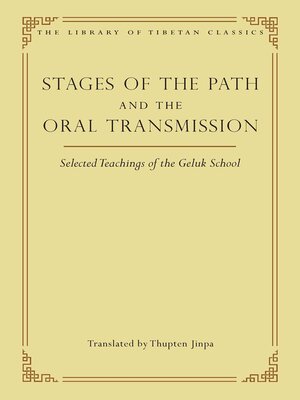Stages of the Path and the Oral Transmission
ebook ∣ Selected Teachings of the Geluk School · Library of Tibetan Classics
By Thupten Jinpa

Sign up to save your library
With an OverDrive account, you can save your favorite libraries for at-a-glance information about availability. Find out more about OverDrive accounts.
Find this title in Libby, the library reading app by OverDrive.



Search for a digital library with this title
Title found at these libraries:
| Library Name | Distance |
|---|---|
| Loading... |
A major contribution to the literature on Buddhist practice according to the Geluk school of Tibetan Buddhism from its foremost interpreter.
Although it was the last major school to emerge in the Tibetan Buddhist tradition, the Geluk school has left an indelible mark on Buddhist thought and practice. The intellectual and spiritual brilliance of its founder, the great Tsongkhapa (1357–1419), has inspired generations of scholars and tantric yogis to place him at the heart of their daily meditative practice. The Geluk tradition's close ties to the Dalai Lamas have also afforded it an outsized influence in all aspects of Tibetan life for centuries. At its peak its combined monasteries boasted a population in the tens of thousands, and its sway encompassed the religious landscape of Mongolia and much of Central Asia.
This widespread religious activity fostered a rich literary tradition, and fifteen seminal works are featured here representing four genres of that tradition. They include works on the stages of the path, or lamrim, the genre for which the Geluk is most renowned; works on guru yoga, centered around the core Geluk ritual Offering to the Guru (Lama Chöpa); teachings from the unique oral transmission of Geluk mahamudra, meditation on the nature of mind; and instructions on the three essential points—what to practice in life, at death, and in the bardo.
Your guide to these riches, Thupten Jinpa, maps out their historical context and spiritual significance in his extensive introduction.
Although it was the last major school to emerge in the Tibetan Buddhist tradition, the Geluk school has left an indelible mark on Buddhist thought and practice. The intellectual and spiritual brilliance of its founder, the great Tsongkhapa (1357–1419), has inspired generations of scholars and tantric yogis to place him at the heart of their daily meditative practice. The Geluk tradition's close ties to the Dalai Lamas have also afforded it an outsized influence in all aspects of Tibetan life for centuries. At its peak its combined monasteries boasted a population in the tens of thousands, and its sway encompassed the religious landscape of Mongolia and much of Central Asia.
This widespread religious activity fostered a rich literary tradition, and fifteen seminal works are featured here representing four genres of that tradition. They include works on the stages of the path, or lamrim, the genre for which the Geluk is most renowned; works on guru yoga, centered around the core Geluk ritual Offering to the Guru (Lama Chöpa); teachings from the unique oral transmission of Geluk mahamudra, meditation on the nature of mind; and instructions on the three essential points—what to practice in life, at death, and in the bardo.
Your guide to these riches, Thupten Jinpa, maps out their historical context and spiritual significance in his extensive introduction.







